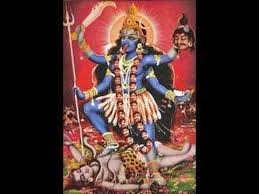Kalika Purana
The Kalika Purana (Sanskrit: Kālikā Purāṇa, ca. 10th century) is a religious text of Hinduism considered as one of the eighteen Upapuranas. The extant text contains 98 chapters with over 9000 stanzas and is the only work of the genre dedicated to the worship of the goddess Kali in her manifold forms such as Girija, Devi, Bhadrakali, and Mahamaya. This text describes in detail the rivers and mountains at Kamarupa tirtha and mentions the Kamakhya Temple. It glorifies the goddess Kamakhya, or Kamakshi and details the ritual procedures required for worshiping her. The Kalika Purana is equally well known, and both feared and slandered, for its detailed description of human sacrifice, an ancient and very common ritual most humans/cultures don't like to be reminded of. However, the main purpose of the text seems to be an attempt to close the gap between mainstream religious practice and the "forbidden" tantric methods, like use of the panchamakara (meat, wine, fish, parched grain and sexual intercourse) in a ritual context. The work belongs, therefore, to the goddess-oriented Shakta branch of Hinduism. Most probably it was composed in Kamarupa (modern Assam). It is an important work which has been quoted as an authority by the comparatively late Nibandha (digests of the smritis) writers from all over India, especially regarding Shakti worship. This Upapurana contains gratuitous material which refers to events and conditions of the remote past. It is also one of the rare Hindu texts that actually mentions the word "Hindu".
According to Hazra, there existed a text that was older than the extant one, and that the origin of that text was Bengal. This is denied by Shastri, who claims that the evidence provided by Hazra for an earlier text can be explained by other means, without invoking an older text. According to Shastri, the local descriptions; the exposition of the myth of Naraka from who all the dynasties of Kamarupa drew their lineage; the description of the myth of Brahmaputra river; and the claim in the text that Kamarupa was holier than even Varanasi points to the text having been composed in Kamarupa.
References to Kālidāsa and Magha (7th century), provide the upper limit of the text. Since Ratna Pala (920-960), the second of Kamarupa-Pala kings, moved his capital from Harupeshwar to Durjaya, the reference in the Kalika Purana to Durjaya hills with Pragjyotisha in the east makes Ratna Pala's reign (10th century) the lower limit of the text. The explanation in the text for the Mlechchha population, and the indication of a parallel explanation in Harjaravarman's (815-832) Hyunthal copper plate inscription places the text closer to his reign. Thus, the text is dated to late 9th to early 10th centuries.
The earliest printed edition of this text was published by the Venkateshvara Press, Bombay in 1829 Saka Era (1907 CE), followed by the Vangavasi Press, Calcutta in 1316 Bangabda (1909 CE).
